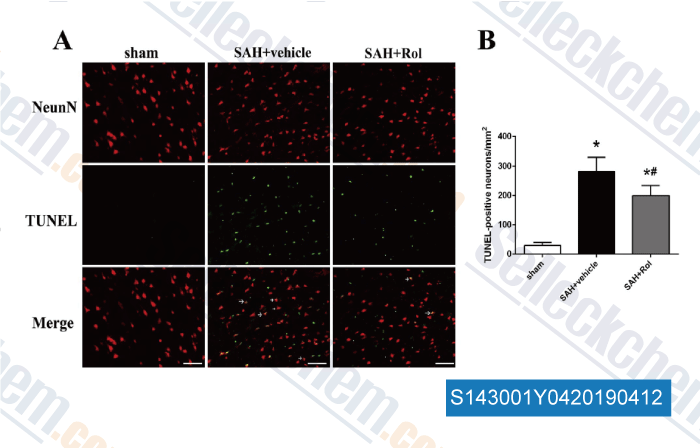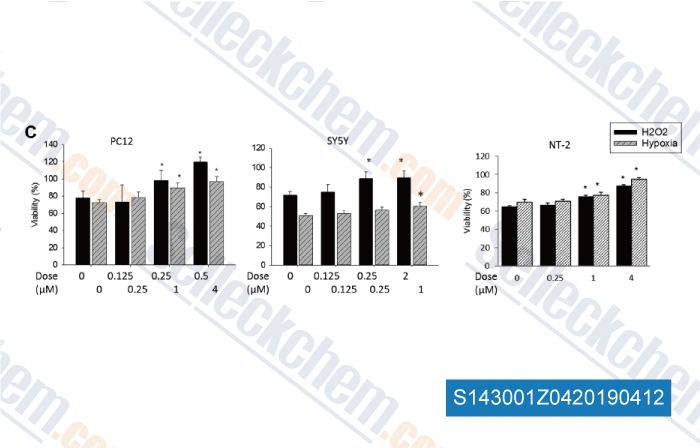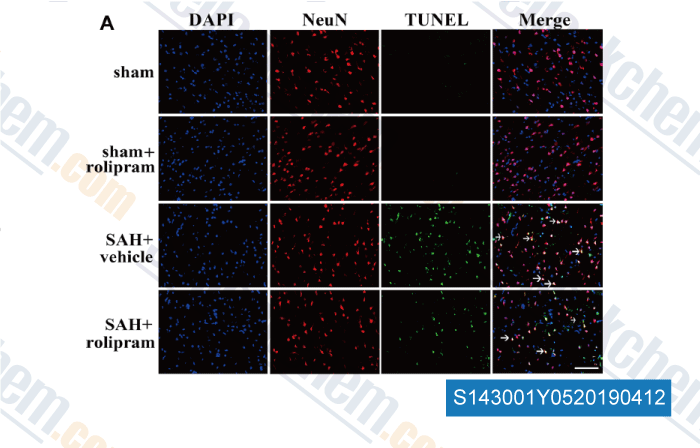|
Toll Free: (877) 796-6397 -- USA and Canada only -- |
Fax: +1-832-582-8590 Orders: +1-832-582-8158 |
Tech Support: +1-832-582-8158 Ext:3 Please provide your Order Number in the email. |
Technical Data
| Formula | C16H21NO3 |
||||||||||||||
| Molecular Weight | 275.34 | CAS No. | 61413-54-5 | ||||||||||||
| Solubility (25°C)* | In vitro | DMSO | 55 mg/mL (199.75 mM) | ||||||||||||
| Ethanol | 55 mg/mL (199.75 mM) | ||||||||||||||
| Water | Insoluble | ||||||||||||||
| In vivo (Add solvents to the product individually and in order) |
|
||||||||||||||
|
* <1 mg/ml means slightly soluble or insoluble. * Please note that Selleck tests the solubility of all compounds in-house, and the actual solubility may differ slightly from published values. This is normal and is due to slight batch-to-batch variations. * Room temperature shipping (Stability testing shows this product can be shipped without any cooling measures.) |
|||||||||||||||
Preparing Stock Solutions
Biological Activity
| Description | The PDE4 selective inhibitor, Rolipram, inhibited immunopurified PDE4B and PDE4D activities similarly, with IC50 values of approx. 130 nM and 240 nM respectively; an anti-inflammatory agent. | ||||
|---|---|---|---|---|---|
| Targets |
|
Protocol (from reference)
References
|
Customer Product Validation

-
Data from [ , , Mol Cancer Ther, 2014, 13(10):2463-73. ]

-
Data from [ , , Biomed Pharmacother, 2018, 99:947-955 ]

-
Data from [ , , J Sex Med, 2016, 13(12):1834-1843 ]

-
Data from [ , , Neurochem Res, 2018, 43(4):785-795 ]
Selleck's Rolipram Has Been Cited by 18 Publications
| P2RY14 cAMP signaling regulates Schwann cell precursor self-renewal, proliferation, and nerve tumor initiation in a mouse model of neurofibromatosis [ Elife, 2022, 11e73511] | PubMed: 35311647 |
| Purinergic Signaling in Neurofibromatosis Type 1: Characterizing the Role of P2RY14 in Neurofibroma Development [ ProQuest, 2022, 30509631] | PubMed: None |
| Roflupram protects against rotenone-induced neurotoxicity and facilitates α-synuclein degradation in Parkinson's disease models [ Acta Pharmacol Sin, 2021, 10.1038/s41401-021-00768-4] | PubMed: 34531546 |
| Rolipram Prevents the Formation of Abdominal Aortic Aneurysm (AAA) in Mice: PDE4B as a Target in AAA [ Antioxidants (Basel), 2021, 10(3)460] | PubMed: 33809405 |
| Release of adenosine-induced immunosuppression: Comprehensive characterization of dual A2A/A2B receptor antagonist [ Int Immunopharmacol, 2021, 96:107645] | PubMed: 33894488 |
| The protective effect of the PDE-4 inhibitor rolipram on intracerebral haemorrhage is associated with the cAMP/AMPK/SIRT1 pathway [ Sci Rep, 2021, 11(1):19737] | PubMed: 34611179 |
| MicroRNA-30d-5p ameliorates lipopolysaccharide-induced acute lung injury via activating AMPKα [ Immunopharmacol Immunotoxicol, 2021, 43(4):431-442] | PubMed: 34157933 |
| Roflupram exerts neuroprotection via activation of CREB/PGC-1α signalling in experimental models of Parkinson's disease. [ Br J Pharmacol, 2020, 177(10):2333-2350] | PubMed: 31972868 |
| Roflupram, a novel phosphodiesterase 4 inhibitor, inhibits lipopolysaccharide-induced neuroinflammatory responses through activation of the AMPK/Sirt1 pathway [ Int Immunopharmacol, 2020, S1567-5769(20)33643-2] | PubMed: 33243606 |
| The diacylglycerol kinase α (DGKα)/Akt/NF-κB feedforward loop promotes esophageal squamous cell carcinoma (ESCC) progression via FAK-dependent and FAK-independent manner [ Oncogene, 2019, 38(14):2533-2550] | PubMed: 30532074 |
RETURN POLICY
Selleck Chemical’s Unconditional Return Policy ensures a smooth online shopping experience for our customers. If you are in any way unsatisfied with your purchase, you may return any item(s) within 7 days of receiving it. In the event of product quality issues, either protocol related or product related problems, you may return any item(s) within 365 days from the original purchase date. Please follow the instructions below when returning products.
SHIPPING AND STORAGE
Selleck products are transported at room temperature. If you receive the product at room temperature, please rest assured, the Selleck Quality Inspection Department has conducted experiments to verify that the normal temperature placement of one month will not affect the biological activity of powder products. After collecting, please store the product according to the requirements described in the datasheet. Most Selleck products are stable under the recommended conditions.
NOT FOR HUMAN, VETERINARY DIAGNOSTIC OR THERAPEUTIC USE.
